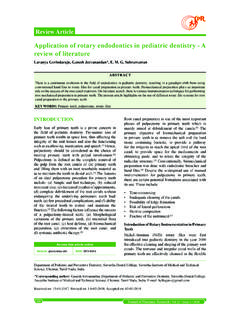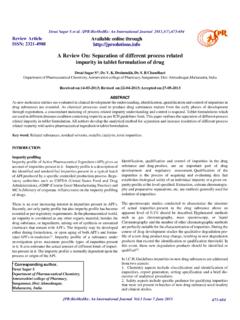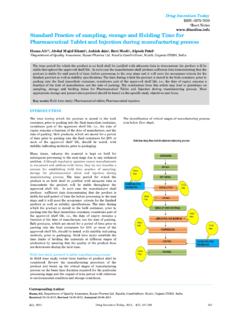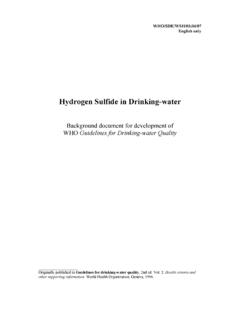Transcription of Formulation and evaluation of Aloe vera gels
1 Journal of Pharmacy Research 2009 Rashmi Tambe et al. / Journal of Pharmacy Research 2009, 2(10),1588-1590 Research ArticleISSN: 0974-6943 Available online Tambe*,Maushumi Kulkarni1, Aney Joice1, Imran Gilani1*Department of Pharmacognosy,1 Department of Pharmaceutics, Society s Allana College of Pharmacy,AzamCampus, Camp, Pune IndiaReceived on: 26-05-2009; Accepted on:17-08-2009 ABSTRACTThe Aloe vera plant is popular and well known for its medicinal uses across the world. The most popularly known species of Aloe vera whichis grown world wide is Aloe barbadensis Miller. Gel derived from Aloe vera is mucilaginous exudate obtained from centre (parenchyma) of theplant leaf. The Aloe vera extract is used for many years as a natural herbal and safe remedy in various skin problems. Several marketedpreparations in the form of gels and lotions containing Aloe vera are available. The present study is an attempt to formulate gel formulationsof Aloe vera using synthetic polymers like Carbopol 934NF, HPMC and PVP36000.
2 These formulations were prepared in concentrations of 1,2 and 3% of respective polymers. These gels were further subjected to evaluation of properties like colour, clarity, pH, consistency, andviscosity measurements. Comparison of the results was done in an attempt to find an optimized Aloe vera gel : Aloe vera gel, polymers, Formulation , evaluation .*Corresponding : + 91-09922964713 Telefax: +91-020- 26442074E-mail: vera is known as a miracle plant which is the derivativeof nature and contains excellent therapeutic value and more thennutritional element. The most popularly known species of Aloe verawhich is grown world wide is Aloe barbadensis Miller (1). Aloe veragel is derived from inside of aloe leaf. It is the mucilaginous gelproduced from centre (parenchyma) of the plant leaf. It is thepreparation which is called pure Aloe vera gel in commerce (2).Many countries such as India, China, Rome, Greece, Egypt are usingAloe vera extract from many years as a natural herbal and safe remedyfor various purposes like to treat skin problems, for beautify regimes,to heal internal and external ailments and to heal wounds.
3 Aloe gel isreported to contain glycoproteins, polysaccharides and otherconstituents (enzymes etc) and are essentially used for the treatmentof various skin conditions (burns, abrasions, bruises, cuts, psoriasis,herpes simplex ).Therefore it is incorporated in ointments and lotionsand other preparations for external and gels made from Aloe vera have become verypopular in the market and used as ayurvedic medicines and cosmet-ics. The gel of Aloe vera contains about 75 nutrients and to be proveda good remedy (3).Polymers are large class of materials consisting of manysmall molecules can be linked together to form long chains. Humanshave taken advantage of versatility of polymers in the form of gums,oils, resins, tar etc. Polymers like Carbopol, HPMC, PVP etc. can beFormulation and evaluation of Aloe vera gelsused to produce thick formulations such as medium to high viscositygels, emulsions, suspensions.
4 They have excellent properties like filmforming, water keeping ability, membranous ability, felting ability andstabilizing property(8).The aim of present study is the Formulation ofAloe vera gel with different ratio of polymers and their evaluation fordifferent parameters like colour, clarity, consistency, spreadability, andviscosityMATERIALS AND METHODS:Aloe vera leaves were collected from Pharmacognosy garden of AllanaCollege of Pharmacy, Azam campus, gel is prepared bypeeling the outer portion of skin and pericarp. Carbopol 934NF, HPMCk15, PVP36000 purchased from Loba Chemie, ofAloe vera gel:The Formulation of Aloe vera gel with differentconcentrations (1%, 2%, and 3%) of Carbopol 934NF, HPMCk15,PVP36000 were prepared. The volume of plain Aloe vera juice waskept 25 ml. in each Formulation . Mechanical stirrer was used for theformulation of gel with different : All formulationswere evaluated physically for colour, odour, consistency, clarity, pH,spreadability and viscosity.
5 Table 1-7 represent observations fordifferent , odour, consistency, and clarity werevisually observed. pH was measured using a pH meter. Viscosity wasdetermined by Brookfield Viscometer (Model CAP 2000+2).Graph andhistogram were plotted between % concentration of polymers andviscosity in AND DISCUSSION:The gels with different concentrations showed differentcolour range from light green to dark green. Odour was characteristicwith all was slightly thick with Carbopol 934 Journal of Pharmacy Research 2009 Rashmi Tambe et al. / Journal of Pharmacy Research 2009, 2(10),1588-1590 Table I: Colour of Aloe vera gel formulationsPreparationConcentration 1%2%3%Aloe vera (plain)Greenish -Aloe vera with carbopol 934 Slightly greenSlightly greenLight greenAloe vera with HPMCG reenishGreenish GreenishAloe vera with PVAG reenishGreenishGreenishTable II: Odour of Aloe vera gel formulationsPreparationConcentration 1%2%3%Aloe vera (plain)characteristic -Aloe vera with carbopol 934 CharacteristicCharacteristicLightAloe vera with HPMCC haracteristicLightNegligibleAloe vera with PVAcharacteristicCharacteristicCharacter isticTable III: Consistency of Aloe vera gel formulationsPreparationConcentration 1%2%3%Aloe vera (plain)Thin -Aloe vera with carbopol 934 Slightly thickThickThickestAloe vera with HPMCM ediumSlightly thickThickestAloe vera with PVAThinMediumthickTable IV.
6 Clarity of Aloe vera gel formulationsPreparationConcentration 1%2%3%Aloe vera (plain)Turbid -Aloe vera with carbopol 934 TurbidTurbidTurbidAloe vera with HPMCT urbidTurbidTurbidAloe vera with PVAT urbidTurbidTurbidTable V: Spreadability of Aloe vera gel formulationsPreparationsConcentration 1%2%3%Aloe vera (plain)Poor -Aloe vera with carbopol 934 GoodBestBestAloe vera with HPMCPoorGoodBestAloe vera with PVAPoorPoorPoorTable VI: pH of Aloe vera gel formulationsPreparationsConcentration 1%2%3%Aloe vera (plain)6 - 7 -Aloe vera with carbopol 9343 - 43 - 43 4 Aloe vera with HPMC677 Aloe vera with PVA4 - 54 - 54 5 Table VII: Viscosity of Aloe vera gel formulationsPreparationViscositySpeed%FS RS hearStressTemp(poise)(rpm)stressrate(oC) Aloe vera (plain) vera with carbopol 934 (1%) vera with carbopol 934 (2%) vera with carbopol 934 (3%) vera with HPMC (1%) vera with HPMC (2%) vera with HPMC (3%) vera with PVA (1%) vera with PVA (2%) vera with PVA (3%) 1: Viscosity v/s Concentration05101520251%2%3%carbopolHPM CPVAV iscosity (poise)Concentration (%)Fig.
7 2: Viscosity v/s polymers0510152025 Aloe veraCarbopol 934 HPMCPVA1%2%3%Viscosity (Poise)Journal of Pharmacy Research 2009 Rashmi Tambe et al. / Journal of Pharmacy Research 2009, 2(10),1588-1590and was thickest with HPMC, while with PVP it was thin and formulations were was observed best in Aloevera with HPMC 3%, while in others it was good and poor. pH valueswere obtained as pH6, pH4, pH5 and pH7 for plain aloe vera gel,carbopol, PVP, and HPMC respectively. Study of plotted graph andhistogram revealed that gels made with Carbopol 934 in the concen-trations of 1%, 2%, and 3% had very low viscosity ( ). Gels madewith PVP in the concentrations of 1%, 2%, 3% had intermediate vis-cosity ( ). While the gels made with HPMC were highly viscousformulations. 1%, 2%, and 3% HPMC gels showed mucilaginous con-sistency and high viscosity amongst all formulated gels which issuitable for application on the skin.
8 Based on the physical evalua-tions, Formulation with HPMC 3% exhibited good physical propertiesand was found to be best choice for preparing gels of aloe vera amongthe Formulation :1. History of Aloe vera History of Biomedicine-Indigenous CulturesKarolinska Institute. Retrieved , Varro, Brady; Pharmacognosy; 9th Edition; Philadelphia, Leaand Febiger; 1988; AY, Foster S. ; Encyclopaedia of Common Natural Ingredientsused in Food, Drugs and Cosmetics; 2nd Edition; John Wiley 1996; J.; Pharmacognosy, Phytochemistry of Medicinal Plants ;2nd Edition; Lavoisier Publishing, Paris; 1993; C, Mo Y, et al. Prevention of Ultraviolet radiation-inducedsuppression of accessory cell function of Langerhans cells by aloevera gel components. Immunopharmacology; 1997; 37; Callister; Jr Material Science and Engineering: An Introduction;5th Edition; Wiley; Monographs on selected medicinal plants, vol I Aids Publishers,India, 46-47, 1st ed, , Udupa , Kulakrni Anti-inflammatory and woundhealing properties of Aloe vera, Fitotherapia, 1994, 65: Ebadi, Pharmacodynamic Basis of Herbal Medicine, Crcpress, Washington , 167.
9 Source of support: Nil, Conflict of interest: None Declar






